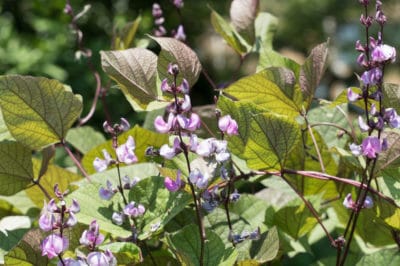Where to Grow Bean Vine
A perennial in USDA zones 10 and above, bean vine can be grown as an annual almost anywhere. When treated as a perennial they may develop thick woody stems like a wisteria, but they tend to be short-lived. Although they prefer full sun and flower best with plenty of heat and light, they will grow in partial shade. However, in partial shade they may also develop fungal diseases.
Bean Vine Varieties
You are unlikely to find many varieties of bean vine in conventional seed catalogs. However, you may find these in specialty catalogs:
- Moonshadow Hyacinth Bean – deep lavender flowers with very deep purple bean pods.
- Red-Leaved Hyacinth Bean – instead of purple, the backs of the leaves are red in color.
- Ruby Moon – purple stems, flowers of lilac rose and deep magenta pods.
Bean Vine Supports
The bean vine is a huge plant, growing as much as 10 to 15 feet long in one season. It must have a strong trellis to support the weight of the plant, especially when wet. Set up the trellis or support well before planting time and make sure it is secure. A metal or strong wood trellis is best, but bean vines will also ramble up into trees.
Planting Bean Vine
Space seeds six to eight inches apart and one to two inches deep in fertile, well-drained soil that is not too high in nitrogen. Seed takes about two or three weeks to germinate. The plant cannot be sown until the weather is warm, but you can start seeds indoors four to six weeks before planting out. Fertilize with organic 5-10-10 fertilizer if necessary.
What Does Mature Bean Vine Look Like?
Strikingly ornamental, the bean vine has bright green pointed leaves. The leaves grow in groups of three and the undersides of the leaves are tinged with purple, as are the stems. Flowers look like sweet peas, although each stem has many more flowers than that of the average sweet pea. Flower color ranges from deep purple through pink to white.
Bean Vine Pods
Initially bean vine pods look like snow peas – green and flat. As the beans develop, the pod begins to resemble that of a soybean. Pods usually have one to three seeds in each. The bean pods develop deeper colors as they grow, progressing from light green through red shade to deepest purple in some varieties. Flowers, immature pods and mature pods are all present on the plant at the same time.
